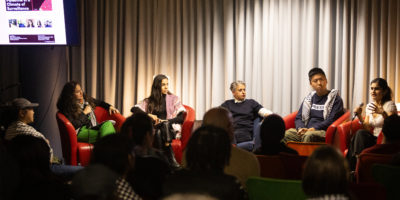By Adam Hunt
In a warehouse the size of an airplane hangar, black muck coats the floor and glazes the square window panels that stretch toward the ceiling. The sun begins to peek its way through the muddy window panes, threatening the once velvety blackness, a feat only the waves and bolts of lasers have been able to accomplish all night. Most of Toronto is asleep. Actually, most of Toronto is about to get out of bed. But the rave is still going strong—line after line of dancers pound their arms violently into the air, conducting the techno orchestra that is performing furiously in their minds.
Thousands of ravers have joined the scene over the last year. Since these clandestine, tribal-style dance marathons came to Toronto, the scene has grown exponentially. Where once a party of 800 ravers was considered big, raves with two to three thousand people are now commonplace. The 1995 new year’s bash boasted about 6000 party-goers.
But growing never comes without pains. While still a healthy, semi-underground culture, the scene has been increasingly beset with commercialization and promoter infighting.
Some say the growth of the scene has changed its character. Raves, fueled by drugs like ecstasy and acid, used to be built on the concept of a tight, communal experience: strangers dancing together to underground techno music, old friends embraced in hugs, people gushing emotion to loved ones and strangers alike.
“No one passed judgements and everyone felt like they could talk to anyone else. We all felt like we were one unit,” remembers longtime raver Colin Atkins, 22. “But now the atmosphere is not nearly as mystical.”
Raves came to Toronto five years ago when four techno-starved British expatriates formed Toronto’s first rave production company: Exodus. They rented a space, hired DJ’s and set up lights and a sound system. They distributed flyers at local clubs and about 400 people showed up. For most of these partiers, Saturday nights would never be the same.
Soon other ravers tried their hand at promoting their own parties, adopting names like Dose Productions, Atlantis and Syrous. There are now over 20 promoters in the Toronto area.
When a subculture grows there is always the potential for it to self-destruct. Witness punk and disco in the late 70’s or the hippie movement. Commercialization is usually behind the death of an underground.
Atlantis is one of the promotions teams that is often held up as a symbol of commercialization. They have held raves at the CN Tower and the Science Centre and have charged $30 a ticket for their Valentine’s Day party.
But Don Berns, an Atlantis member and a DJ under the name “Dr. Trance,” wonders what people mean when they throw around the label “commercial.”
“People talk about it but don’t really have an answer,” Berns says. “To me something that’s too commercial is advertised on television or with a full-page-ad in Now magazine. If you have DJs playing music that you’re not going to hear anywhere else then to me it’s not commercial.”
As for high ticket prices, Berns cites escalating costs as an explanation. Promoters sometimes spend up to 40 or 50 thousand dollars on a production in order to ocmpete with other companies. They want the best flyers—sometimes costing as much as $8000—the best sound, a large location and an incredible light show.
Berns notes that even with $30 tickets, high costs and an extremely cold night led to a loss of $10,000 on their last rave.
Libby Shields, 19, has been a rave fixture since the beginning. She remembers the days when the nascent scene revolved around 23 Hop, a club on Richmond St. “You’d show up just hoping something was going on. Now there’s at least one party every weekend,” she says. “Now it’s on the radio. There’re flyers everywhere. Every record store. People are going to high schools and flyering. It used to be just word of mouth…it’s not underground anymore. It’s nothing secret. It’s nothing special.”
Tickets for most raves can even be purchased through Ticketmaster.
But Shields thinks the focus on money was inevitable: “If the promoter is going to invest so much time, work and money, why wouldn’t they want something to show for it at the end?”
Back at the rave, hundreds of skinny, loose-limbed freaks with pointy, friendly faces poking out from under their floppy hats, are talking and smoking and staring and dancing: maneuvering like assembly line workers folding invisible boxes and screwing on imaginary bolts.
There are tons of freaks tonight, with their faux-jet packs, face glitter, gas masks and skin-tight mini-shorts.
One girl is sheathed in a red rubber top with a stuffed monkey on her back and a white fluffy afro wig on her head. Her mantis-like legs shoot down from a yellow polyester skirt and land in a pair of sneakers with four inch soles.
Some say the spirit she embodies is in jeopardy: Bev May, editor of the rave zine “Transcendence,” believes raves started as a political statement. She says they represented tolerance, multiculturalism, unity and the freedom to be yourself.
“When you walked out of the door of that rave you weren’t the same person you were when you came in. You had bonded with the other people and learned about yourself,” she says.
Old ravers talk endlessly about the “vibe” created by the dancing, the drugs and the ravers’ attitudes (or lack thereof). Peace and harmony were the goals of every party. One love.
But May thinks the atmosphere is changing: “When people go to raves now, they’re there to show off their new rave outfit and smoke dope…You get more of a younger, entertainment-oriented, hedonistic kind of a crowd.”
The size of parties are partly to blame for the less intense vibe. Most of the big promoters, like Toronto’s most successful company, Pleasure Force, seem to subscribe to the view that bigger is better. “For some of them, this is their personal vision of how the scene should evolve,” says Bev May. “But other promoters may just be seeing dollar signs.”
Recently, a new trend has begun: on the nights of the larger raves, competing smaller parties are being held. Unfortunately, instead of acting as a friendly alternative to the bigger raves, they have created tension among promoters.
The night of the last Atlantis party, there was a smaller rave called “The Rebirth of Rave Culture.” According to Don Berns, the intention of the small party was revenge on the Atlantis crew.
Another promoter had put out a flyer poking fun at the scene. Some of the other promoters assumed they were the targets. When Berns tried to defuse the situation, everyone assumed he was behind the flyer.
To get back at Berns, and to challenge the Atlantis vision of what a rave should be, the “Rebirth of Rave Culture” was born. “The whole reason for it was so fucking negative,” says Berns. “They put out flyers that said don’t support the cheese, the next good party is Syrous (another promoter with a rave the next week). That’s an insult to anybody who’s every gone to or played at Atlantis and had a good time.”
Berns said a lot of the negativity comes out of the rave shop X-static, which is owned by a member of promotions giant Pleasure Force.
“Those guys have a certain style of party that they all like and they have a lot of communication with the kids because they hang out there,” explains Berns. “So what they say is treated like gospel and its not necessarily true.”
X-static is the rave centre of Toronto. The Queen and John St. shop serves as ticket outlet, clothing shop, music vendor and hangout for the city’s ravers. But it also serves as booster for Pleasure Force and the promoters who are friends with the Pleasure Force crew (Syrous, Dose, etc.)
On nights where there are two events, X-static has been known to push tickets for the party of their liking, even after the customer has asked for a ticket to the competitor’s rave. In December when there were Destiny and Dose raves on the same night, they refused to sell tickets to the Destiny party, or even allow flyers for it in the store.
X-static’s people also have a reputation for bad mouthing some of the other production companies: labeling their music and atmosphere “cheesy”—a hurtful rave insult.
“I won’t deny that some negative stuff was coming out of the store at all,” admits X-static manager Brian Ireland. “There has been some slagging that’s gone on. But I think the people at X-static realize there’s no need to do that crap anymore. We’re telling everybody to just get along and I think that’s going to happen.”
Some promoters are trying to get past all the fighting. An all-promoters rave, set for this summer to soothe tensions is in the planning stages. If it goes as planned, the massive event will bring Pleasure Force, Atlantis and all other promoters together to throw one big party.
But for now, the fragmentation and in-fighting in the rave scene threatens the spirit of it all. “People go on about the rave culture and how it’s all about unity and community and people coming together,” says Libby Shields. “Meanwhile everybody’s backstabbing each other. It’s very superficial.”
Don Berns would like to see some changes in attitude: “You can be positive about the scene and if you don’t like something, just don’t go…Hopefully there’s room in this city for everything. And if not, then it shouldn’t be called a rave because what’s going on around here now is not what raving’s all about.”










Leave a Reply